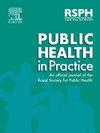Reaching national Covid-19 vaccination targets whilst decreasing inequalities in vaccine uptake: Public health teams' challenges in supporting disadvantaged populations
IF 1.9
Q2 PUBLIC, ENVIRONMENTAL & OCCUPATIONAL HEALTH
引用次数: 0
Abstract
Background
UK local authority public health teams (LAPHT) supported delivery of the Covid-19 vaccination programme, particularly to disadvantaged populations. We explored the challenges encountered and lessons learnt by LAPHTs in tackling low Covid-19 vaccine uptake. The aim of this study was to understand what works, and how, in addressing local inequalities in relation to uptake of the Covid-19 vaccination with a view to generalising insights to building back fairer after the pandemic and into the future.
Study design
Qualitative.
Method
We conducted in-depth on-line interviews with Directors of Public Health or their representatives from 21 English local authorities covering a total population of over 8 million people. Data were analysed thematically.
Results
Accessing the requisite (and accurate) data, engaging with communities, and working with National Health Service (NHS) organisations presented challenges in delivering initiatives to improve vaccine uptake, particularly for disadvantaged groups. LAPHT's assets beneficial to the programme - in-depth knowledge and experience of their communities and locality - were not considered in the national vaccination programme. Community engagement and relationships with local NHS featured heavily in the majority of LAPHTs responses to improving vaccine uptake rates.
Conclusions
Incorporating local public health infrastructure, expertise and existing relationships into national vaccination planning during epidemics or pandemics is crucial. Community engagement and good relationships with NHS staff help to reach and serve disadvantaged populations. How these can be developed and maintained in the longer term without future investment was a concern. Future research should explore the design and implementation of PH and NHS joint service delivery models to tackle health inequalities, informed by experiences of the Covid-19 vaccination programme and with input from community partners.
实现国家 Covid-19 疫苗接种目标,同时减少疫苗接种中的不平等现象:公共卫生团队在支持弱势群体方面面临的挑战
背景英国地方当局公共卫生团队 (LAPHT) 支持 Covid-19 疫苗接种计划的实施,尤其是针对弱势群体。我们探讨了 LAPHT 在解决 Covid-19 疫苗接种率低的问题时遇到的挑战和吸取的经验教训。本研究的目的是了解在解决与 Covid-19 疫苗接种率相关的地方不平等问题时,哪些方法有效,以及如何有效,以便将这些见解推广到大流行后和未来的更公平建设中。研究设计定性方法我们对来自 21 个英国地方当局的公共卫生主任或其代表进行了深入的在线访谈,这些地方当局的总人口超过 800 万。结果获取必要(准确)的数据、与社区接触以及与国民健康服务(NHS)机构合作,是实施提高疫苗接种率(尤其是弱势群体的疫苗接种率)计划所面临的挑战。LAPHT 对计划有益的资产--对社区和当地的深入了解和经验--在国家疫苗接种计划中没有得到考虑。在大多数 LAPHT 为提高疫苗接种率而采取的应对措施中,社区参与以及与当地 NHS 的关系占据了重要位置。社区参与以及与 NHS 工作人员的良好关系有助于接触和服务弱势群体。如何在没有未来投资的情况下长期发展和维持这些关系是一个值得关注的问题。未来的研究应借鉴 Covid-19 疫苗接种计划的经验并参考社区合作伙伴的意见,探索公共卫生服务和国民保健服务联合服务模式的设计和实施,以解决健康不平等问题。
本文章由计算机程序翻译,如有差异,请以英文原文为准。
求助全文
约1分钟内获得全文
求助全文

 求助内容:
求助内容: 应助结果提醒方式:
应助结果提醒方式:


